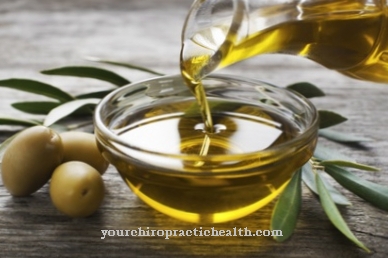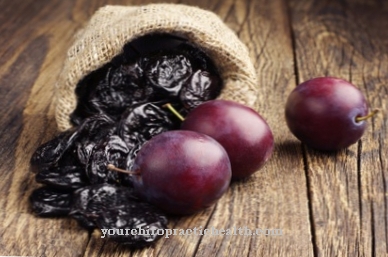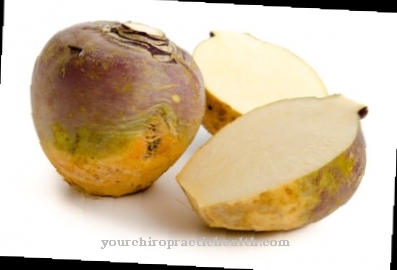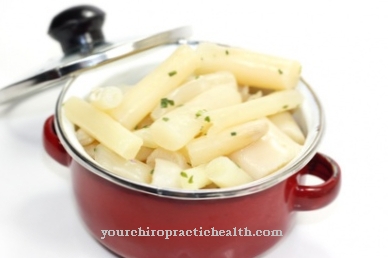The Oat root is an almost forgotten root vegetable that has been cultivated for thousands of years. Its leaves are also edible. In taste and use, the oat root is very similar to the garden black salsify. Further names are: White root, Milk root, Purple goatee, Habermark, Marrow root or Oyster plant.
What you should know about oat root

The oat root belongs to the sunflower family. Its Latin name is Tragopogon porrifolius. It belongs to the genus of goatee plants. Oat root blooms purple and spreads its seeds like a dandelion in the wind. The long taproot is the main vegetable.
It becomes up to 30 cm long with a diameter of approx. 3.5 cm. Its leaves grow out of the root tip as a rosette and are visually reminiscent of leeks. The original home of the oat root is in the Mediterranean. There it was already cultivated and grown as a vegetable during antiquity. The long tradition of cultivation is proven by written records. More than 2000 years ago, the Greek naturalist and philosopher Theophrastus of Eresos described the "tragopogon" as a food. Over the centuries, their cultivation spread to Central and Northern Europe. During the Middle Ages it became a popular vegetable in Germany as well.
From the 16th and 17th centuries, the garden salsify, imported from Spain, replaced the agricultural cultivation of the oat root. Both root vegetables are very similar in terms of nutritional values, taste and use in cooking. The garden black salsify, however, has the more productive rhizomes and is more robust against frost. That makes their cultivation more worthwhile. In contrast to the garden black salsify, the oat root has a yellowish-white root bark. Because of this cream-colored cork layer, it is also called white salsify to distinguish it from salsify. Its great advantage: the white root does not have to be peeled. The light-colored root bark is edible.
Their root meat is white and - like the black salsify - traversed by milk tubes that secrete a sticky milky juice. In the air it oxidizes and turns brown. Nowadays, the oat root is only cultivated to a significant extent in England. Organic agriculture has also rediscovered this old cultivated plant and is growing it here and there. The biennial plant develops its rhizome with a rosette of leaves in the first year. The flowering takes place in the following year. The flower stalks reach a height of 100-120 cm. However, since the vegetable root becomes woody and dry when flowering begins, the harvest begins in October in the first year.
In light frost, the root becomes sweeter. Therefore, oat roots are still sold in winter. The taste is similar to black salsify. However, oat roots do not have asparagine, which creates a slight asparagus taste in garden black salsify. Instead, oat root contains carotenoids and has a sweet to nutty-bittersweet taste of beetroot. The milky juice adds another flavor. It is compared to the taste of an oyster. This is where the name oyster plant comes from.
Importance to health
The oat root contains many healthy nutritional values. In the Alemannic vernacular, the saying was passed down: "Habermark makes d 'Bube strong". The inulin it contains is of particular importance. It is a polysaccharide. This multiple sugar is broken down into fructose, i.e. fruit sugar, in the stomach.
In contrast to glucose, the grape sugar, fructose hardly affects the blood sugar level. Therefore, the oat root is very suitable for diabetics and a dietary diet. Oat root is also gluten-free. It perfectly complements the menu for people with a gluten intolerance. The consumption of oat root supports the formation of red blood cells and the liver is better detoxified. The oat root can have a healing effect on bladder and gallbladder diseases as well as arteriosclerosis.
Ingredients & nutritional values
White root convinces with a high proportion of vital minerals. The most important are potassium, calcium and magnesium. There are also carotenoids and vitamins as well as inulin.
Intolerances & allergies
Intolerance can arise for people with sensitive or weakened gastrointestinal tract. After consuming oat roots, the mentioned inulin can cause mild digestive problems in those affected. Other intolerances are unknown.
Shopping & kitchen tips
Oat roots are not sold in supermarkets. The cultivation quantities are too small for that. You are most likely to find what you are looking for at a weekly market with farm direct marketing. Organic farms also sometimes offer these vegetables. The season starts from autumn to winter. Then the online search can also be worthwhile.
Various suppliers have vegetable boxes or a vegetable order service on offer. It is not very easy to find oat root in the free trade. An alternative can be cultivation in your own garden. Loose, rather sandy soil is required. But be sure to take heed that the roots are harvested well before the flowers are set. Otherwise they are no longer edible. When purchasing, transporting and harvesting your own food, make sure that the roots are not damaged. Otherwise the milky sap will leak out and the roots will lose their taste. The oat roots can be stored in the refrigerator for about two weeks. To do this, they are wrapped in cling film and placed in the vegetable compartment. We recommend wearing a kitchen apron and rubber gloves for preparation.
If the sticky milky juice gets on clothes or hands, cleaning will be tedious. If the roots still have leaf matter, the leaves should be cut off and stored immediately before preparation. They can be used for various recipes. Before processing, the roots must be cleaned. This is done with a brush under running water. Well-cleaned roots do not have to be peeled, which simplifies kitchen work. In the other case, peeling with a potato peeler is recommended. This can lead to brown discolouration because the milky sap oxidizes.
The freshly peeled roots should therefore be placed in vinegar water or a mixture of water with flour until processing. A third variant is blanching. To do this, the roots are boiled for a short time in water or vinegar and then poured cold over them. Then the cork bark can simply be peeled off the root meat.
Preparation tips
The oat root is a versatile vegetable. The leaves can be cooked like spinach. They are also suitable as a soup or in salads. Even the flowers of the oat root can be used as a side salad. However, they should be cooked briefly before use. The root can be grated raw and processed into a delicious salad.
It goes well with carrots, horseradish and parsnips, nuts and apples. Yoghurt, sour cream or lemon, seasoned with chervil or parsley, make a delicious dressing. As a root vegetable, the oat root is a good accompaniment to fish and meat. It tastes delicious with cream or bechamel sauce. The roots can also be processed into puree. Breaded or unbreaded - cut into strips - it can be fried in the pan and as a meat substitute it can support a vegetarian diet.



























